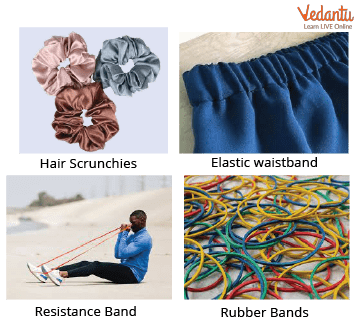




How Do Elastic Materials Work? Key Concepts for Students
Have you ever stretched a rubber band? Think about why you can stretch a rubber band but not a book. This is because of the phenomenon called elasticity and materials such as a runner band are known as elastic materials. So, let's move on and discuss this in detail.
Elasticity is a material's propensity to regain its original shape after being subjected to forces. Elastic materials are those that after the elastic deformation is eliminated, revert to their original dimensions and shapes. Elastomers are elastic materials that when bent, return to their original shape. Elastic rubber bands show the property of elasticity. Their shapes can be changed on stretching and can come back to their original position when left. In this article, you will learn which materials are elastic and examples of elastic materials.

Elastic Material

Different Shapes and Sizes of Elastic Bands
Elastic Behaviour of Materials
When we extend a slingshot, the force we apply causes it to deform. However, when we remove the force, the deformation returns to its original shape. This property is known as elasticity, and it indicates that when stress is applied, the body resists any lasting change. When stress is removed, the body returns to its original size and shape. From this, we can easily distinguish which materials are elastic.

Changing and Regaining Shape of Elastic Material
Let's imagine that a band has been made in a thin steel rod. When it begins to bend slightly, the use of force must be discontinued. The rod doesn't change back to how it was originally. Different sorts of behaviour of materials can be seen depending on its elastic and plastic nature.
Applications of Elastic Material
The following is the list of some of the applications of elastic material:
To make living more convenient, safe and stable human-made constructions like skyscrapers and overbridges are designed with elastic materials at important junctures.
They are also used for making pillars and beams. Rubber balls which you use while playing cricket. Your stretchable toothbrush, etc. all have elastic materials.
They are used for manufacturing automobile parts.
They are used for manufacturing kitchen utensils.
There are many more examples where elastic materials are used. Your yo-yo toy also has elastic material attached to it. When you look around, you will also observe some examples. The jumping ball present in your toy box is also made from an elastic material.
Examples of Elastic Material
Now, we are going to see the elastic materials list:
Elastin
Rubber
Nylon
Lycra
Rubber
Gum
Wool
Silicon
Polyester
Balloons
They all exhibit elasticity. Since they recover to their previous shape after enduring deformations like compression and expansion, springs are one of the finest examples of elastic force. Toys like spring heads, toy phones, and other items can utilise springs in a variety of ways. The goal of a trampoline is specifically to take advantage of the elastic force for fun. A trampoline is made from a particular elastic material.

Example of Elastic Materials
Facts of Elastic Material
An object is elastic if you can twist, bend, stretch, or squeeze it, and when you let go, it returns to its original shape. Most solid materials display some degree of elastic behaviour, but for each material, there is a limit to the amount of the force and the associated deformation within which elastic recovery is achievable. Since their volumes alter in response to pressure, gases and liquids also have elastic qualities. Rubber is the most elastic material, and glass would have the least elasticity. Elasticity is the capacity of a material to return to its former shape after being stretched.
Summary
Some materials swell when you compress them while others stretch if you pull them. They return to their normal size, location, or shape as you release your grip. These substances are referred to as elastic substances, and this property is referred to as elasticity.
Rubber, an elastic substance used in balloon construction, enables the balloon to stretch when filled with air. Additionally, some fabrics are created with elastic properties. Synthetic fabric with exceptional stretchability is spandex. Clothing for cyclists and swimmers is made from it.
FAQs on Elastic Materials: Meaning, Properties & Applications
1. What is an elastic material in science?
An elastic material is any substance that possesses the property of elasticity. This means it has the ability to be temporarily deformed by an external force—such as being stretched, compressed, or bent—and will return to its original size and shape once the force is removed. A classic example is a rubber band snapping back to its original form after being stretched.
2. What are some common examples of elastic materials?
Elastic materials are commonly used in many everyday objects. Some important examples include:
- Rubber: Used in vehicle tires, elastic bands, and gloves.
- Steel: Although it seems rigid, steel is highly elastic and is used in springs, bridges, and building frames to handle stress.
- Spandex (Lycra): A synthetic fibre known for its exceptional elasticity, which is why it's used in sportswear and other fitted clothing.
- Nylon: Often used in ropes and parachutes because it can stretch under a load and absorb shock.
- Sponge: A porous material that can be easily compressed and will expand back to its original shape.
3. How do elastic materials differ from inelastic or plastic materials?
The key difference lies in how they respond to external forces. An elastic material returns to its original shape after a deforming force is removed. In contrast, an inelastic (or plastic) material undergoes a permanent change in shape and does not return to its original form. For instance, if you stretch a rubber band (elastic), it snaps back, but if you bend a piece of modelling clay (inelastic), it stays bent.
4. Why is steel considered more elastic than rubber, even though rubber stretches more easily?
In physics, elasticity isn't about how much something can stretch, but about how strongly it resists being deformed and how forcefully it returns to its original shape. Steel has a much higher resistance to deformation. It requires a significant amount of force to cause even a small stretch, and it snaps back with great force. This high resistance to a change in shape means steel has a higher Young's Modulus (a measure of stiffness and elasticity), making it scientifically more elastic than rubber.
5. What happens to the energy used to stretch an elastic material?
When you apply force to deform an elastic material, the work you do is stored inside the material as elastic potential energy. This energy is held within the stressed atomic bonds of the substance. When the external force is released, this stored potential energy is converted into other forms, primarily kinetic energy (the energy of motion) as the material snaps back, and some is lost as heat and sound.
6. Is there a limit to how much an elastic material can be stretched and still return to its original shape?
Yes, every elastic material has an elastic limit. This is the maximum stress or force that can be applied to the object before it starts to deform permanently. If a material is stretched beyond its elastic limit, it will not fully return to its original shape and may become permanently elongated or even break. This is why a spring can be overstretched and ruined, or a rubber band can snap if pulled too hard.









